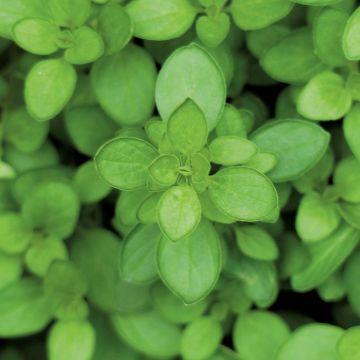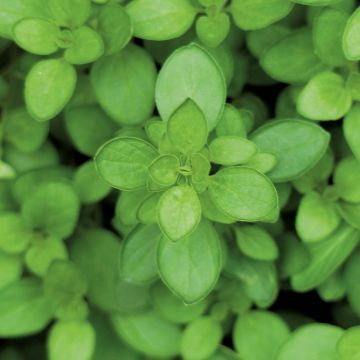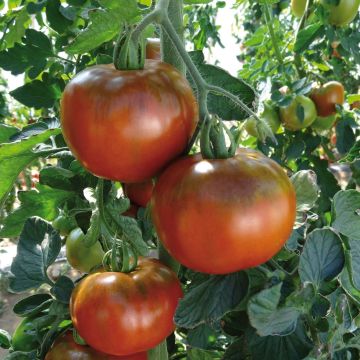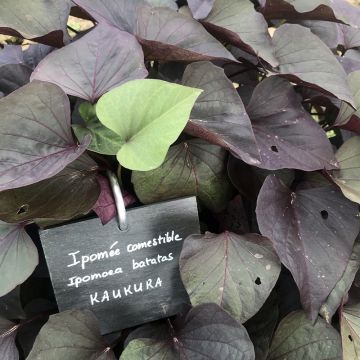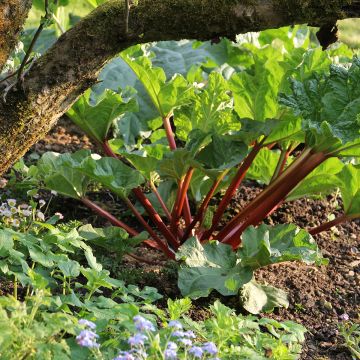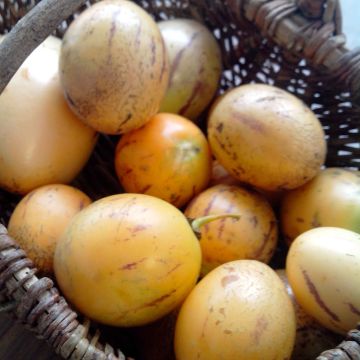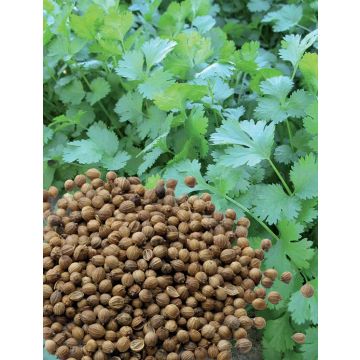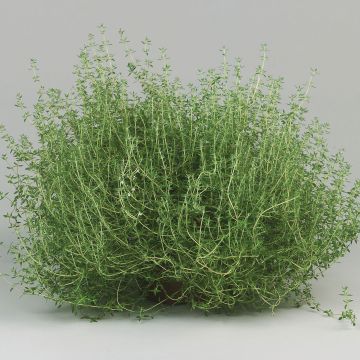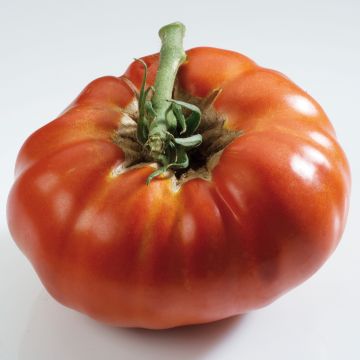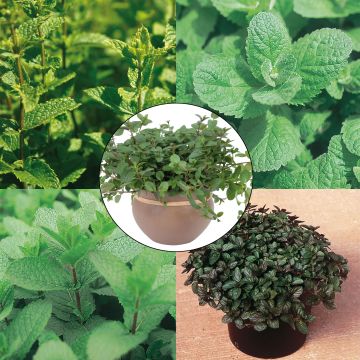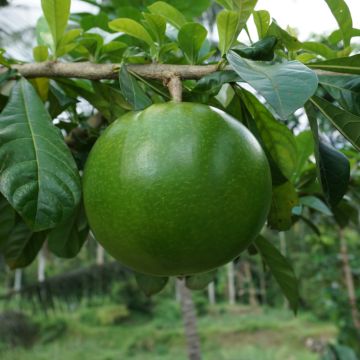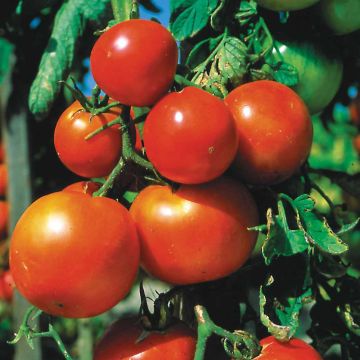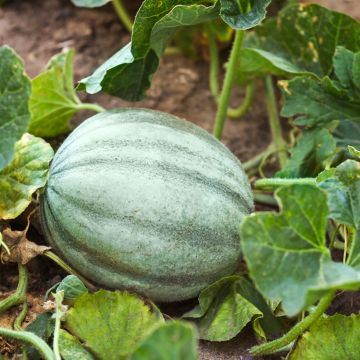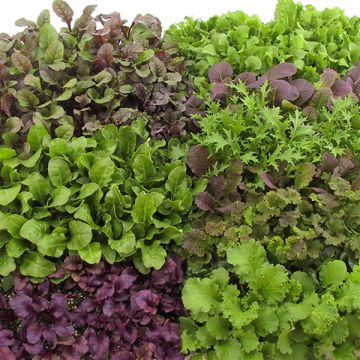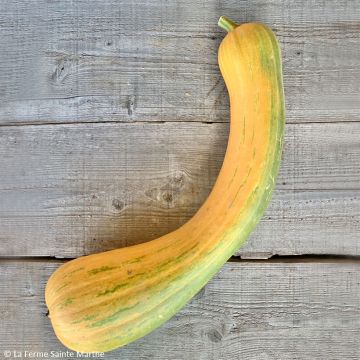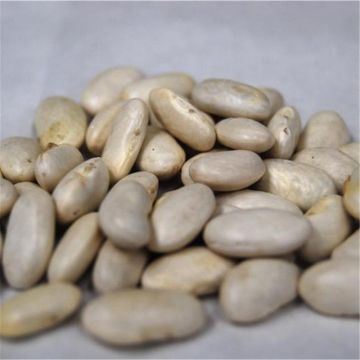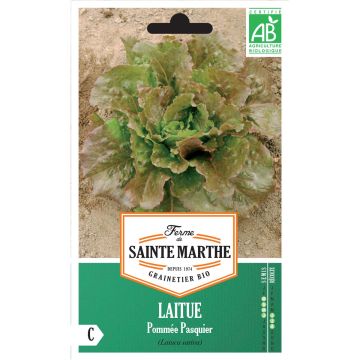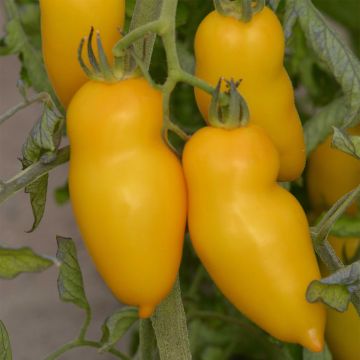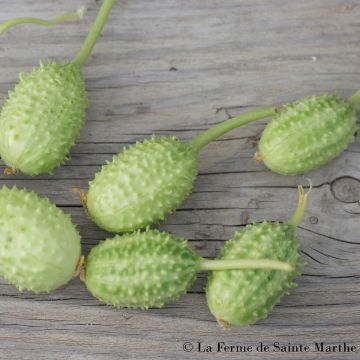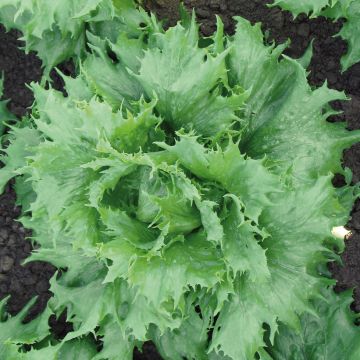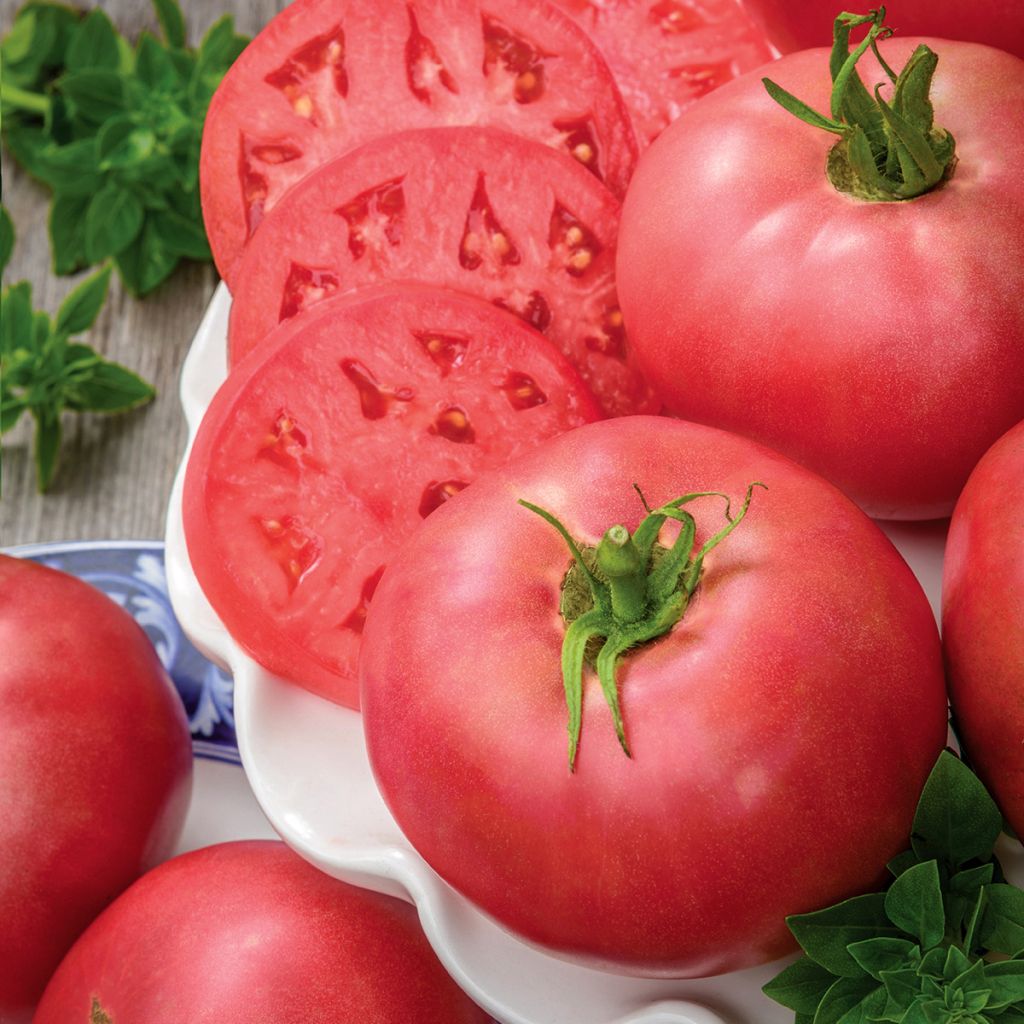

Tomate Rose Crush en plant BIO
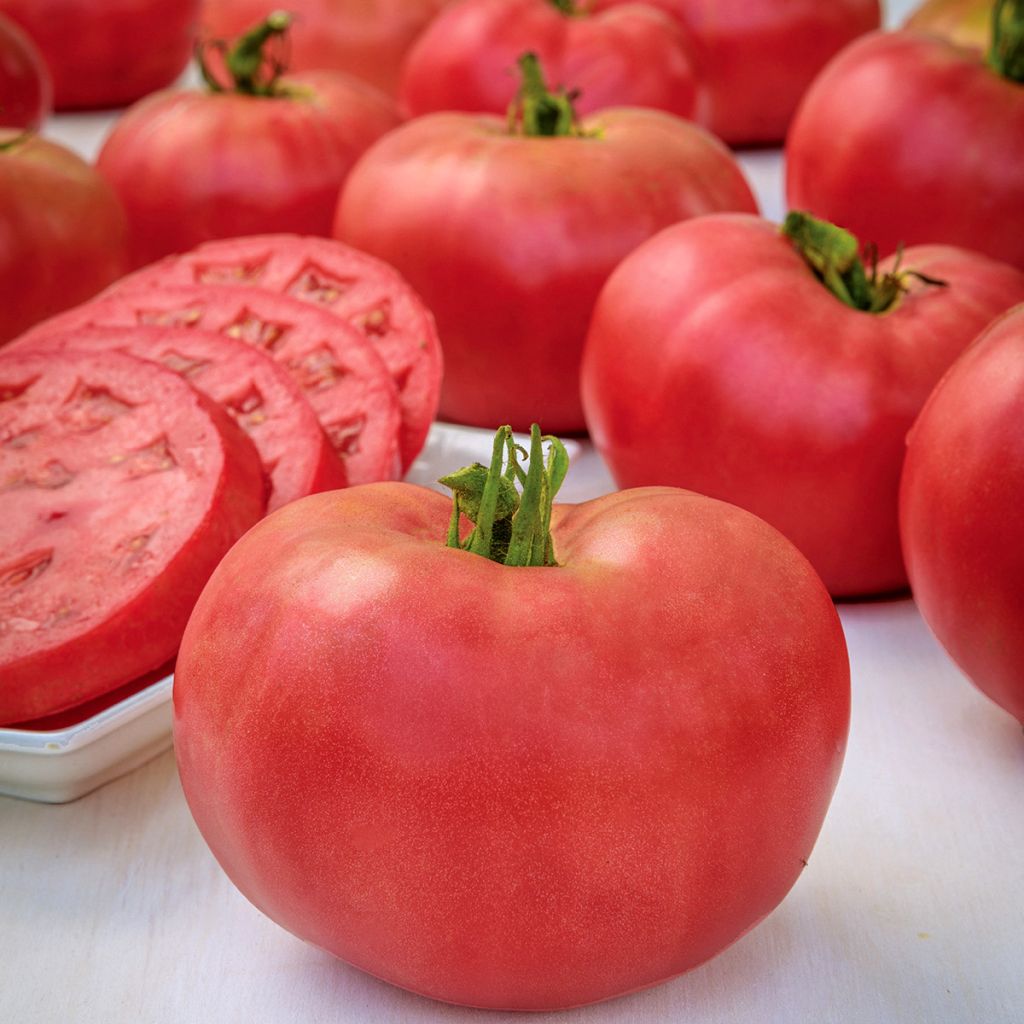

Tomate Rose Crush en plant BIO
Tomato Rose Crush Organic
Solanum lycopersicum Rose Crush
Tomato
This item cannot be shipped to the selected country
Delivery charge from €5.90
More information
Schedule delivery date,
and select date in basket
This plant carries a 6 months recovery warranty
More information
We guarantee the quality of our plants for a full growing cycle, and will replace at our expense any plant that fails to recover under normal climatic and planting conditions.
From €5.90 for pickup delivery and €6.90 for home delivery
Express home delivery from €8.90.
Description
The Organic Pink Crush Tomato is a recent variety, similar to the Rose de Berne type, that is semi-early and exceptionally resistant to blight. It produces large, round fruits with pink skin, each weighing between 200 and 250 grams, which are appreciated for their slightly sweet pink flesh. The vigorous plants have indeterminate growth and can reach up to 2m (7ft) in good conditions. With their bushy habit, they are suitable for both open ground and container cultivation on balconies. The Rose Crush can be enjoyed raw in summer salads or cooked in various dishes. Young plants should be planted from April to June, depending on the climate, after the last frost. Harvest from July to October.
Its large pink fruits can adorn a balcony or terrace, provided the location is warm and sunny! Cultivate it in a large container with holes at the bottom and lined with clay balls to facilitate water drainage. Fill the container with quality compost mixed with compost, then add a handful of roasted horn before planting the tomato. Place the container in a corner so that the plant is sheltered from the wind and benefits from the heat radiating from the walls. Water regularly.
The tomato is native to South America and Central America. Several varieties were already cultivated by the Incas long before the arrival of the Conquistadors. The term "tomate" comes from the Inca word "Tomatl" and refers to both the plant and the fruit it produces. It is one of the many foods that came to us from the New World, along with beans, corn, squash, potatoes, and chili peppers. The tomato took significantly longer to reach our taste buds. For a long time, it was cultivated for its aesthetic and medicinal qualities, but it was considered toxic due to its resemblance to the fruit of the Mandrake, another Solanaceae plant. It only became a regular part of our diets in the early 20th century.
The tomato is a perennial herbaceous plant in tropical climates, but it is grown as an annual in colder regions. It becomes lignified over time and produces small insignificant yellow flowers grouped in cymes, which then transform into fruits. Tomatoes can be grown in open ground, but they can also be grown in containers on a balcony, especially smaller varieties.
It is a fruit vegetable that offers numerous nutritional benefits. Low in calories like most vegetables, it is rich in water and contains a very interesting molecule: lycopene, a powerful antioxidant. It is also rich in vitamin C, provitamin A, and trace elements.
In terms of cooking, tomatoes can be consumed raw or cooked in various ways: in salads or as appetizers, grilled, stuffed, marinated, preserved, in ratatouille, as a sauce, in kebabs, etc. They come in all colors, shapes, and sizes. Take advantage of this and cultivate several varieties in your vegetable garden to enjoy a variety of flavors!
Harvest: 'Rose Crush' is a semi-early variety that can bear fruit from late June or July to October, depending on the planting date and the climatic and cultivation conditions (in a greenhouse or in open ground). There is no foolproof way to determine when a tomato has reached full ripeness. Harvesting should be done when, at the very least, the tomato is completely colored as announced and its texture, while still firm, shows a slight softening. For better storage, be sure to pick the fruit with its stem.
Storage: Tomatoes should be stored at an optimal temperature of 10-15°C (50-59°F). They can be kept for a few days in the vegetable drawer of your refrigerator or spread out in the open air. However, refrigeration alters the taste qualities of the fruits. To keep them longer, consider culinary methods such as tomato confit, sun-dried tomatoes, sauces, frozen fruits, preserves, jams, or juices. We love confit tomatoes because they are simple and so delicious: cut your tomatoes in half and collect the juice. Place the tomato halves, cut side up, on the grill pan of your oven. Season with salt, pepper, and sugar, then bake at a very low temperature for at least an hour. Remove the tomatoes and consume them immediately, or store them in a glass jar and cover them with olive oil.
Gardening tip: To reduce the need for watering, we recommend mulching the soil with thin successive layers of grass clippings, if possible mixed with dead leaves. This protective layer helps retain moisture in the soil and also reduces weed growth. It is advisable to cultivate several tomato varieties each year to minimize the risk of a complete loss of harvest due to climatic events or specific diseases.
To prevent the phenomenon of 'blossom end rot' in tomatoes - which is not a disease but a calcium deficiency - spray a consoude maceration rich in calcium on your plants.
Report an error about the product description
Harvest
Plant habit
Foliage
Other Vegetable plants A to Z
Planting and care
Tomato plants are easy to grow. Sunlight and warmth play a crucial role in the success of this crop. Tomatoes thrive in rich, well-drained soil that is deeply cultivated. A few months before planting, add well-rotted compost after loosening the soil. If your soil is heavy, add some sand at the time of planting.
Initially, allow the plug plants to grow by transplanting them into 8 to 10.5 cm (3 to 4in) buckets filled with potting soil. Then place them in a sunny and heated location: the temperature should never drop below 12-14°C (53.6-57.2°F), otherwise the foliage will turn yellow and the growth of the plant will stop. When the plants reach a height of about 15 cm (6in), transplant them into the ground if the external temperatures allow it.
Transplanting into the ground should be done once the risk of frost is no longer present, usually after the Ice Saints in mid-May. Choose a very sunny and sheltered location. Space the plants 50 cm (20in) apart in rows and 70 cm (28in) between rows if you prune, or 1m (0 or 3ft) in all directions for unpruned cultivation. Dig a hole (3 times the volume of the plug plant), add a little well-decomposed compost at the bottom of the hole. Place your plant, which can be buried up to the first leaves, then fill in the hole. Firm the soil, create a basin around the base and then water generously. Be careful not to wet the leaves to protect your plants from fungal diseases.
Install supports (soon after planting to avoid damaging the roots). Mulch around the base of the plants. Water regularly, as irregular watering can lead to calcium deficiency, resulting in a condition known as 'blossom end rot'.
Furthermore, tomatoes, like potatoes, are susceptible to blight. This is a fungal disease caused by the Phytophthora infestans fungus. Blight develops in warm and humid weather. Small spots appear, white on the underside of the leaves and green-gray on the upper side. To minimize risks, space the plants adequately and avoid watering the foliage. In terms of crop rotation, wait 4 years before growing a plant from the Solanaceae family in the same location and do not cultivate them in neighboring rows. If necessary, spray with Bordeaux mixture or preparations such as horsetail decoction or garlic purin.
Less common, growing tomatoes in pots is still possible by choosing varieties with small fruits and placing the pot in a very sunny location.
Cultivation
Care
Intended location
This item has not been reviewed yet - be the first to leave a review about it.
Organic vegetable gardens
Haven't found what you were looking for?
Hardiness is the lowest winter temperature a plant can endure without suffering serious damage or even dying. However, hardiness is affected by location (a sheltered area, such as a patio), protection (winter cover) and soil type (hardiness is improved by well-drained soil).

Photo Sharing Terms & Conditions
In order to encourage gardeners to interact and share their experiences, Promesse de fleurs offers various media enabling content to be uploaded onto its Site - in particular via the ‘Photo sharing’ module.
The User agrees to refrain from:
- Posting any content that is illegal, prejudicial, insulting, racist, inciteful to hatred, revisionist, contrary to public decency, that infringes on privacy or on the privacy rights of third parties, in particular the publicity rights of persons and goods, intellectual property rights, or the right to privacy.
- Submitting content on behalf of a third party;
- Impersonate the identity of a third party and/or publish any personal information about a third party;
In general, the User undertakes to refrain from any unethical behaviour.
All Content (in particular text, comments, files, images, photos, videos, creative works, etc.), which may be subject to property or intellectual property rights, image or other private rights, shall remain the property of the User, subject to the limited rights granted by the terms of the licence granted by Promesse de fleurs as stated below. Users are at liberty to publish or not to publish such Content on the Site, notably via the ‘Photo Sharing’ facility, and accept that this Content shall be made public and freely accessible, notably on the Internet.
Users further acknowledge, undertake to have ,and guarantee that they hold all necessary rights and permissions to publish such material on the Site, in particular with regard to the legislation in force pertaining to any privacy, property, intellectual property, image, or contractual rights, or rights of any other nature. By publishing such Content on the Site, Users acknowledge accepting full liability as publishers of the Content within the meaning of the law, and grant Promesse de fleurs, free of charge, an inclusive, worldwide licence for the said Content for the entire duration of its publication, including all reproduction, representation, up/downloading, displaying, performing, transmission, and storage rights.
Users also grant permission for their name to be linked to the Content and accept that this link may not always be made available.
By engaging in posting material, Users consent to their Content becoming automatically accessible on the Internet, in particular on other sites and/or blogs and/or web pages of the Promesse de fleurs site, including in particular social pages and the Promesse de fleurs catalogue.
Users may secure the removal of entrusted content free of charge by issuing a simple request via our contact form.
The flowering period indicated on our website applies to countries and regions located in USDA zone 8 (France, the United Kingdom, Ireland, the Netherlands, etc.)
It will vary according to where you live:
- In zones 9 to 10 (Italy, Spain, Greece, etc.), flowering will occur about 2 to 4 weeks earlier.
- In zones 6 to 7 (Germany, Poland, Slovenia, and lower mountainous regions), flowering will be delayed by 2 to 3 weeks.
- In zone 5 (Central Europe, Scandinavia), blooming will be delayed by 3 to 5 weeks.
In temperate climates, pruning of spring-flowering shrubs (forsythia, spireas, etc.) should be done just after flowering.
Pruning of summer-flowering shrubs (Indian Lilac, Perovskia, etc.) can be done in winter or spring.
In cold regions as well as with frost-sensitive plants, avoid pruning too early when severe frosts may still occur.
The planting period indicated on our website applies to countries and regions located in USDA zone 8 (France, United Kingdom, Ireland, Netherlands).
It will vary according to where you live:
- In Mediterranean zones (Marseille, Madrid, Milan, etc.), autumn and winter are the best planting periods.
- In continental zones (Strasbourg, Munich, Vienna, etc.), delay planting by 2 to 3 weeks in spring and bring it forward by 2 to 4 weeks in autumn.
- In mountainous regions (the Alps, Pyrenees, Carpathians, etc.), it is best to plant in late spring (May-June) or late summer (August-September).
The harvesting period indicated on our website applies to countries and regions in USDA zone 8 (France, England, Ireland, the Netherlands).
In colder areas (Scandinavia, Poland, Austria...) fruit and vegetable harvests are likely to be delayed by 3-4 weeks.
In warmer areas (Italy, Spain, Greece, etc.), harvesting will probably take place earlier, depending on weather conditions.
The sowing periods indicated on our website apply to countries and regions within USDA Zone 8 (France, UK, Ireland, Netherlands).
In colder areas (Scandinavia, Poland, Austria...), delay any outdoor sowing by 3-4 weeks, or sow under glass.
In warmer climes (Italy, Spain, Greece, etc.), bring outdoor sowing forward by a few weeks.

































